Topic area
Human and economic
Geography
Sub-topic area
Economic activities
Key unit competence
By the end of this unit, you should be able to
investigate the impact of power and energy
production on sustainable development in
Rwanda.
Unit objectives
By the end of this unit, you should be able to:
• Recall the forms of energy used in
Rwanda and the difference between
renewable and non renewable energy.
• State factors favouring power production
in Rwanda.
• Give the importance of power and
energy in Rwanda.
• Identify the factors that hinder the
potential exploitation of rivers in Rwanda
in production of power and energy.
Major sources and forms of energy used in Rwanda
 Activity 15.1
Activity 15.1 Work in pairs.
1. Define energy.
2. Use the Internet and other geographical
documents, identify the major sources
of energy used in Rwanda.
3. Classify the sources as either renewable
or non-renewable and state their
difference.
4. Write down your findings and discuss
them in a class presentation.
Power is the ability to do work. Energy
is power derived from the utilisation of
physical or chemical resources, especially to
provide light and heat or to work machines.
Energy is essential in the manufacturing
process in which goods and services are
produced, processed and transported. The
sources of energy used in Rwanda include;
wind, hydroelectric power, solar, natural
gas, biogas and petrol.
The sources of energy are classified into
two. They are renewable and non renewable
sources of energy.
(a) Renewable sources of energy These are sources of energy that cannot be
exhausted. They have the capacity of refilling
themselves after being used. The production
of such energy is endless because the
energy is regenerated naturally. In Rwanda,
the renewable sources of energy that are
in use include the ones listed in table 15.1.
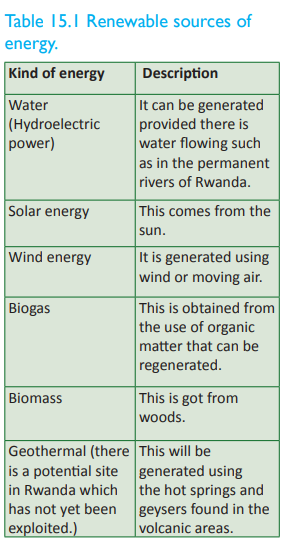 (a) Hydroelectric power
(a) Hydroelectric power
This is power that is generated from running
water. A dam is constructed along a river
to store water. The water is then made to
fall over a turbine. The turbine rotates and
this rotation causes it to turn on the electric
generator that produces electricity.
Rwanda’s major rivers have proven
potential to support hydropower plants
in a total of 333 sites across the country.
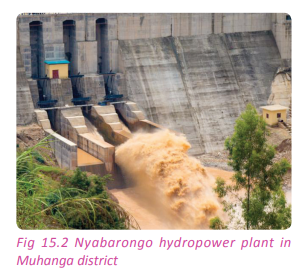 (b) Solar energy
(b) Solar energy
This is energy derived from radiation from
the sun. It is obtained by the use of solar
panels which directly transform sun light
into electricity. The solar power station in
Rwanda is located in Jali in Gasabo District
Kigali Province.
 (c) Biogas
(c) Biogas
Biogas is used in some homesteads and
institutions in Rwanda. It is obtained from
organic matter such as cow dung. It is
used to provide light, for cooking and for
domestic heating.
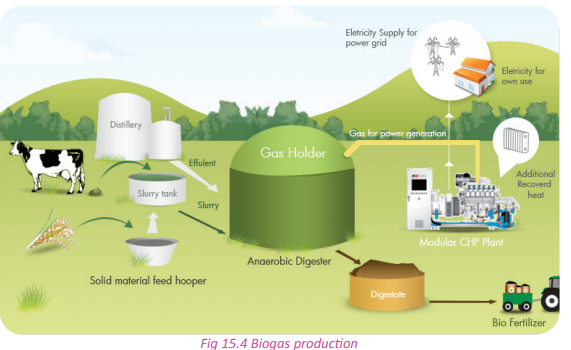 (d) Biomass
(d) Biomass This is the energy produced from organic
matter (plants and animals). It is used in the
form of firewood, charcoal or agricultural
residues. It is mainly used as a source
of energy in cooking. This is the most
commonly used form of energy in the rural
areas of Rwanda
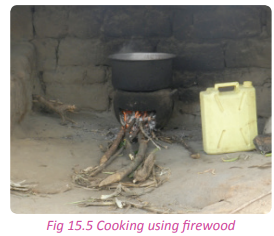 (e) Geothermal energy
(e) Geothermal energyThe source of this energy is from the huge
amounts of heat within the earth. The
heat in the Earth’s interior is tapped as
geothermal energy. Superheated steam
from heated underground water is used
to turn turbines which run generators that
produce power.
This source of energy is not yet in use in
Rwanda. Examples of geothermal energy
potential sites in Rwanda are around Lake
Kivu, Nyakabuye in Bugarama and Rugaryi
in Western Province. Technical exploration
studies are being conducted.
The estimated potential for power
generation from geothermal energy is more
than 700 MW.
Non-renewable sources of energy These are forms of energy that can be
depleted. Examples of this energy include
the following
(a) Oil This is a source of energy that involves
the burning of fossil fuels especially oil or
petroleum to run generators. Currently,
the oil products consumed in Rwanda are
valued at 90,000 tonnes. Since there is no oil
in Rwanda, petroleum products in Rwanda
are imported.
(b) Peat coal
These are charcoal-like-material deposits
that are under the earth’s surface. It is
present in the swamps of Eastern Province
of Rwanda. It is extracted in the swampy
areas of Kamiranzovu and along River
Akanyaru. It is used to generate power in
homes and other institutions. An example
of a peat extraction centre is the Gisagara
peat power plant.
(c) Methane gas
An estimated 100 to 150 million cubic
metres of methane gas is generated
annually in Lake Kivu.
The quantity of methane available in Lake
Kivu is believed to be sufficient to power
700 MW of electricity generation over a
period of 55 years. Rwanda’s proportion is
350 MW (50%).
Activity 15.2
Work in groups of three.
Despite the depletion and overutilisation
of the non-renewable sources of energy
in Rwanda, the energy sources can still be
harnessed.
1. Giving examples, suggest ways in which
renewable and non renewable sources
of energy in Rwanda can be protected
and efficiently utilised.
2. Write down your suggestions and
discuss them in a class presentation.
Activity 15.3 Work in pairs.
Power production in Rwanda is not fully
exploited.
1. Suggest ways in which the Rwanda
government can improve on the
utilisation of the sources of energy
that are available in the country.
2. Write up a report on your suggestions
and present it in class.
Task 15.1
1. Differentiate between power and
energy.
2. Giving examples, distinguish between
renewable and non renewable sources
of energy.
The factors favouring power
production in Rwanda
Activity 15.4
Your teacher will organise a field visit for you
to a power station. In groups of five;
1. Find out the factors that favour power
production in the station.
2. Write a report on the factors that have
favoured power production in the
station.
3. Using the Internet and other
geographical documents, find out other
factors that favour power production.
4. Write down your findings and discuss
them in a class presentation.
There are several factors that have favoured
power production in Rwanda. They include
the following:
(a) Supportive government policies such
as the establishment of the rural
electrification program.
(b) Presence of large volumes of water
in the rivers for the generation of
hydroelectric power.
(c) Availability of ready internal and external
markets for the power.
(d) The availability of waterfalls and hard
rocks that favour the generation of
hydroelectric power.
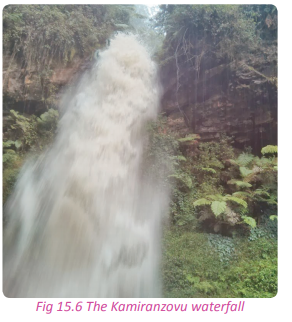
(e) The political stability that prevails in the
country has enabled the established
power and energy stations to run.
(f) The availability of capital to buy the
equipment that is needed for setting up
the power generating stations.
g) Availability of advanced technology.

Availability of skilled labour in all levels.
(i) The presence of forests such as
Nyungwe, Gishwati and other private
forests.
(j) The availability of a variety of sources
of power that include solar, peat coal,
wind and biogas.
The importance of power in
the development of Rwanda
Case Study Dusabimana Justin is a student in one of the
schools in the Western Province of Rwanda.
She is a day scholar. She is the oldest child
in her home and she always has to help
around with household chores. She hardly
got time to revise her school work and do
her homework. To add onto her problems,
there was no power in her home.
After sometime, thanks to the rural
electrification programme, her home was
connected to the national grid.
She began studying at night and doing
her homework in time. Her performance
in class improved. Her mother stopped
using firewood because she could now
afford to use a cooker. They also bought
rechargeable lamps. Her school uniform
was neat because she could easily iron it.
During the weekends, she could listen to
music and watch her favourite programmes
on television. In a location that is not far
from her home, a tea factory was opened
that provided employment to the people
in her sector. The area soon developed into
an urban centre because of the activities
around the tea factory.
(a) Name the source of power that changed
Justin’s life.
(b) List the importance of power from
Justin’s story.
(c) Find out and discuss other importance
of power that are not highlighted in
Justin’s story.
(d) Write down your answers and discuss
them in a class presentation.
Activity 15.5 Look at the area near your home, school
and the nearest urban centre;
1. Write down your observations on the
importance and uses of power in the
mentioned areas.
2. Find out the contribution of power to
the economy of the regions mentioned
and to the country as a whole.
3. Write down your findings and discuss
them in a class presentation.
The availability of power is important in
the development of Rwanda as discussed
below.
(a) Power is important for domestic uses
hence raising the standards of living of
the people.
(b) Power is important in the development
of industry. Most industries use
electricity and petroleum to run engines
in the industries.
(c) Petroleum is used to run vehicles hence
facilitating transport systems in the
country.
(d) Petroleum and electricity are often
used to run water pumps and other
agricultural machinery.
(e) Electricity contributes a lot in running
activities in schools, hospitals and
printing industries.
(f) Power contributes to the growth and
development of urban centres.
(g) Power contributes to the development
of trade and commerce by facilitating
the operations of the various businesses.

The availability of power helps in making
an area a potential tourist attraction
centre.
The problems hindering the
development of energy and
possible solutions in Rwanda
Activity 15.6 Works in pairs.
Use the Internet, Geography textbooks and
other geographical documents;
1. Find out the problems that hinder the
development of energy in the country.
2. Suggest possible solutions to the
problems you have identified.
3. Use your findings for a class discussion.
The power and energy development
in Rwanda is affected by a number of
challenges. They include the following:
(a) Limited technological advancement This forces the country to depend on foreign
nations. This increases the cost of energy
production.
(b) Poor economic structures This has limited the market for power and
energy since a large proportion of the
population is not economically empowered.
(c) Illiteracy
Due to illiteracy, part of the rural population
in the country is hesitant to use electricity.
(d) Climatic changes Much of Rwanda still uses hydroelectric
power which depends on the availability of
water in the rivers. When there is drought
the production of electricity is affected.
(e) The break-down of facilities Due to poor technology, sometimes
breakdown of machines disrupt power
generation and distribution. Sometimes,
the country has to depend on expatriate
expertise. This causes delays and is also
expensive raising the cost of power
production.
(f) Lack of adequate capitalSetting up of power stations is a very capital
intensive venture. The capital needed is
usually not readily available because of
other competing needs.
(g) Limited alternative sources of
power
Due to the use and dependence on hydro
electricity, the other alternative sources
of energy have not been developed. This
creates a power shortage in the country
whenever it fails.
 Limited research
Limited research
Research is very important in harnessing
power. The ability and resources to
research further on hydroelectricity power
production as well as in other alternative
sources of energy is limited.
(i) Inaccessibility of some areas that
are power potential sites
Due to the hilly and mountainous terrain of
the country, it is difficult to construct roads and other infrastructure. This limits access
to other areas that are power generation
potential sites.
(j) Silting and flooding A majority of the rivers in Rwanda carry a lot
of eroded materials from the mountainous
areas. They end up depositing a lot of silt
and mud on their river beds. The silt may
interfere with the generation of power.
(k) Water weeds
The heavy presence of water weeds
interferes with the flow of rivers and thus
the flow of water that is required in the
generation of hydroelectricity.
(l)Opposition from the
conservationists
The generation of hydroelectricity is
sometimes hindered by conservationists
who are opposed to the damming of rivers
for environmental conservation reasons.
Possible solutions to the
problems affecting power and
energy production in Rwanda
Activity 15.7 1. Suggest solutions to the power
shortages and surges that are frequently
experienced in Rwanda.
2. Write down your suggested solutions
and present them in a class discussion.
Some of the solutions to the problems
affecting power and energy production in
the country include the following:
(a) Use of diversified sources of energy In many areas of Rwanda, homesteads have
been connected to renewable power such
as solar energy. This mostly works in rural
areas and in urban areas as an alternative
to hydroelectric power.
(b) Efficient transmission and
distribution power This has been one of the government’s top
agenda. It has been implemented through
the rural electrification programme that has
assisted many homes to have power.
(c) Emphasise on the use of renewable
energy
Both the government and private sector
in Rwanda emphasise on the need to use
renewable energy sources such as wind and
solar energy.
(d) Construction of more power
plants The construction and establishment of more
power stations especially hydroelectric
power stations will help in boosting power
production in the country.
(e) Training human resource
The government should commit itself in
training more people in power and energy
specific courses. These people will help in
providing the much needed expertise in the
energy sector.
(f) Creation of buffer areas around
power stations.
The creation of protected areas and buffer
zones of 50 metres around water bodies and
power stations will assist in reducing the silting
of dams and power stations in the country
(g) Harvesting of water weeds
There should be more effort put in the
harvesting of water weeds especially the water hyacinth which is steadily spreading
in the country’s water bodies.
 Regular inspection of machinery
Regular inspection of machinery
There should be regular inspection of
machines and equipment used in the
production of power and energy. This will
help in avoiding mechanical problems such
as transformer breakdowns.
(i) Construction of feeder roads
Roads should be constructed to open up
potential power sites in the rural areas. This
will enable investors to invest in power and
energy production in the remote areas.
(j) Dredging the rivers and water
reservoirs behind the dams
There should be an effort to remove the silt
that is deposited around the dams.
(k) Affordable prices The government together with other parties
involved in the production of power and
energy should device a fair power pricing
system. This will make power affordable and
available to all.
(l) Environmental assessment reports
There should be serious environmental
assessment studies carried out before and
during the power production periods. This
will help to prevent environmental hazards
beforehand.
(m)Mass education
The people of Rwanda should be educated
on power and energy saving ways in order
to avoid unnecessary power wastage.
 Importing power
Importing power
The government of Rwanda should import
power from other neighbouring countries
where power, especially hydroelectric
power is in abundance.
Task 15.2
1. Discuss three factors that favour power
production in Rwanda.
2. Explain the importance of power to the
development of Rwanda.
3. Give five problems hindering the
development of power and energy in
Rwanda.
Case studies (a) Mukungwa I and II power stations
These power and energy generating stations
are located in the Northern Province of
Rwanda in Musanze district. They are all
situated along River Mukungwa. Which
connects Lakes Burera and Ruhondo. River
Mukungwa is an outlet of Lake Ruhondo.
Water that flowed from the hills to this lakes
was tapped into a dam to generate electricity.
The site was suitable for the construction of
the dam and due to the waterfalls from the
hills and the presence of hard rocks.
The Mukungwa I power station is located
at the geographical coordinates that
lie between latitude: 1°32’16.08” and
longitude: 29°41’3.12”. It is found at an
altitude of about 1651 metres above sea
level. The power station produces about 12
Mega Watts (MW) of power.
Its construction began in 1978 and it began
its operations in 1982. The station produces
power of differing voltages basing on the
need for the power generated.
There is one section that produces high
voltage power that is meant to supply
power and energy to Kigali while the other
section produces medium voltage power
that serves Musanze and Rubavu towns
with their associated rural areas. The power
station faces the challenge of reduction of
the water levels in the dam that causes
reduced power generation. As an effort to
boost the electricity generation capacity
of the station, another station, Mukungwa
II was constructed to provide additional
power to the national power grid.
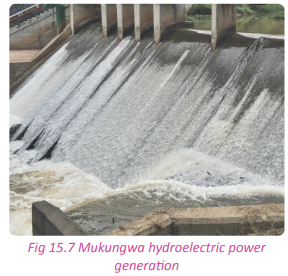
Mukungwa II on the hand began its
operations in 2010. It produces 2.5MW of
power to the national power grid.
These two power stations have created
employment opportunities and provided
reliable power supplies to the various
institutions. The stations are responsible for
the development of Musanze town which
is a major tourist urban centre in Rwanda.
(b) Rusizi II power station
This power station was developed on River
Rusizi which is the only outlet of Lake Kivu.
Rusizi I was established in 1958 while Rusizi II
power station was constructed in 1989. The
operations and management of these two
power stations was a joint project between
Rwanda and her partners who are Burundi
and the Democratic Republic of Congo. The
Rusizi I power project has the capacity of
producing 30 MW of hydroelectric power
while Rusizi II has a capacity to produce
approximately 44 MW of power.
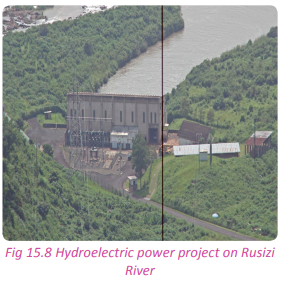 Activity 15.8
Activity 15.8
Work in groups of five.
Your teacher will organise for you to visit a
hydroelectric power station in the country.
While on the site, observe the following;
1. The major source and form of energy
in the station visited.
2. Classify the energy as either renewable
or non-renewable.
3. Find out the factors that favour the
production of the power at the station.
4. Find out the challenges in the production
of the form of energy produced at the
station.
5. Suggest possible solutions to the
problems identified.
6. Write a report on your findings and
observations.
7. Report your findings in a class
presentation.
Activity 15.9
Do this in pairs.
1. Through the concerned ministries, find
out the government’s long term plan in
coping with the increasing demand for
power due to the increasing population.
2. Suggest ways in which the government
will cope with the increasing demand for
power with the increasing population.
3. Write a report on the findings of your
investigations and suggestions.
4. Present your findings and suggestions
in a class presentation.
Did you know?
• Electricity accounts for only about 4%
of primary energy use in Rwanda
• Biomass contributes 85% and petroleum
products account for the rest.
• The country currently has about 96 MW
of installed capacity
• Approximately 13% of households are
connected to the grid.
• Current electrification rate for Rwanda
is 9% with 142,697 connections.
• Rwanda’s electrical energy derives
chiefly from hydroelectric sources.
• All of Rwanda’s refined petroleum
products are imported.
• Rwanda has no proven reserves of
coal, crude oil, or oil refining capacity,
although the country has proven
reserves of natural gas.
End of unit revision task
1. (a) Name and describe the sources of
power and energy used in Rwanda.
(b) Distinguish between renewable
energy and non-renewable energy in
the context of Rwanda.
2. To what extent is the presence
of waterfalls responsible for the
development of power and energy
production in Rwanda?
3. Examine the advantages of using the
following sources of power and energy in
Rwanda.
(a) Biogas
(b) Hydroelectric power
(c) Solar energy
4. Explain the differences that exist between
biomass and biogas as sources of energy
used in Rwanda.
5. Examine the factors that have favoured
power production in Rwanda.
6. (a) Define rural electrification.
(b) Explain why the government of
Rwanda advocates for transmission
and distribution of power and
energy to rural areas.
7. Analyse the importance of power
production to the economic development
of Rwanda.
8. Describe the effects of power generating
stations and operation on the environment.
9. Explain how you would address the
challenges affecting power production in
Rwanda.
10. (a) Name two areas where hydroelectric
power stations are found in Rwanda.
(b) Explain the factors that favoured
power production in any one of the areas
identified in (a) above.
11. Study the table below and fill in the areas
in Rwanda where the respective energy
production takes place.

Availability of skilled labour in all levels.
The availability of power helps in making an area a potential tourist attraction centre.
Limited research
Regular inspection of machinery
Importing power
